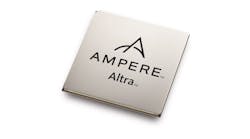Arm Server-Chip Startup Ampere Computing Preps for IPO
Ampere Computing, a startup designing Arm-based central processors for servers, said it has confidentially filed with the U.S. Securities and Exchange Commission for an initial public offering.
An offering would give the Santa Clara, California-based company a key source of expansion cash. The proceeds from an IPO would likely aid its ambitions to capture a larger slice of the server-chip market.
The company said it had started the paperwork with the SEC, but it’s not sharing further details. According to SEC rules, companies can keep their listing documents private for a period leading up to a public offering.
The number of shares to be offered and pricing for the proposed IPO have yet to be determined. Ampere expects the offering to occur after the SEC completes its review. Whether it moves ahead with the IPO depends on the market and other conditions, according to the company.
Ampere was founded in 2017 by former Intel president Renee James, who serves as CEO and chairman of the startup. Ampere designs server chips based on Arm’s instruction set architecture (ISA) that aim to challenge x86 chips made by AMD and Intel. Ampere’s Altra and other Arm CPUs are gaining ground in the data center, as cloud giants opt for chips that compete in terms of performance while wasting less power.
The startup has amassed more than $425 million in funding since it was founded from a very short list of investors, including Arm. Ampere raised its largest round of funding yet—a total of $300 million—roughly a year ago from Oracle, which has adopted the Altra CPUs, based on Arm's Neoverse N1 CPU design, to try to become more competitive in the cloud market. James also holds a seat on Oracle’s board.
The Oracle-backed company is trying to expand its footprint in the cloud, too. Microsoft entered the Arm server-chip era last week. It previewed new services from its Azure cloud unit powered by the Altra CPU. Microsoft said servers using Ampere’s chips deliver 50% better performance-per-dollar than x86 equivalents such as AMD’s EPYC or Intel’s Xeon. The Altra integrates 80 cores that clock at up to 3 GHz.
Power efficiency is a top priority in the cloud, as it helps keep the sector’s share of global electricity use in check and reduces the carbon footprint of the likes of AWS, Google, Microsoft, and Oracle. Around 1% of the world’s electricity is siphoned by the cloud sector. The power efficiency of Arm’s architecture, which has also turned it into the de facto standard in smartphones, allows many more single-threaded cores to fit on a CPU.
Ampere has outlasted most of its rivals, including Marvell and Qualcomm, which have halted research and development on Arm server chips. That has left Ampere as one of the last remaining players in the space.
While Ampere has been able to woo customers that operate enormous cloud data centers, it is far from dethroning server CPUs from AMD and Intel CPUs—and underlying x86 ISA—that dominate the data center.
Few companies have deep enough pockets to develop a server CPU—a category of data-center chips that frequently sell for thousands of dollars apiece. The proposed IPO would give it a new way to access capital over time, by selling stock on the public market. The capital could help it keep up with the soaring costs of chip development and maintain its growth. Funding could also help bolster its efforts to lure customers.
Though the company currently uses Arm’s Neoverse N1 cores for its Altra and 128-core Altra Max chips, which came out in 2020 and 2021, it plans to take a page out of Apple’s playbook and develop CPU cores from the ground up for future generations. It will start with a 5-nm server CPU due in 2022. This requires a so-called “architectural” license from Arm, which carries a higher cost than Arm’s off-the-shelf CPU cores.
The startup could use the funds from the IPO to hire more engineering talent and speed up the development of chips with better performance per watt than x86 alternatives and Arm’s off-the-shelf CPU blueprints.
The filing comes as Arm reportedly prepares for its IPO after the collapse of its proposed sale to NVIDIA for $40 billion. Since the deal fell apart earlier this year, Arm has apparently opted for an IPO as its backup plan.
Other upstarts in the semiconductor industry are also weighing the pros and cons of an IPO. SiFive, a startup designing CPU cores based on the RISC-V ISA, said last month it is preparing for an IPO by 2024.

